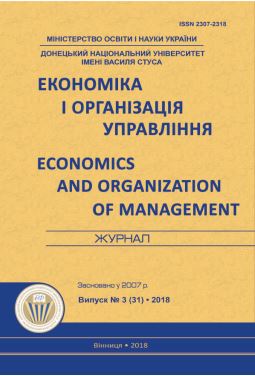Competitiveness of labour force: problems of the formation and realization under conditions of innovative changes at labour market.
DOI:
https://doi.org/10.31558/2307-2318.2018.3.3Keywords:
competitiveness of labour force, competitive advantages, labour market, risks, innovative factorsAbstract
The article investigates the conditions for increasing the competitiveness of the labour force, in particular the need for updating of knowledge, skills, qualifications and the formation of a favorable socio-psychological climate and appropriate working conditions. It is proved that the innovative factors of development connected with providing of the technological upgrading of production, increasing the readiness of labour force to innovate changes became the priorities under globalization. The possibility of achieving a high level of competitiveness of national economies based on the mobilization of efficiency and innovation factors, creation of the conditions for realization of competitive advantages of the labour force at the domestic and foreign labour markets is substantiated. The specific features of the formation and implementation of competitive advantages of the labour force, determined by the peculiarities of the nature and content of labor, in which the consumer qualities of the labour force are used, are investigated. It is proved that the formation of competitive advantages of the labour force is connected with the existing demographic, labour and social potential of individual individuals and the population as a whole, as well as opportunities for their effective using and development. It is substantiated that strengthening the role of the creative nature of labour in the conditions of innovative changes (with a decrease in the importance of strictly regulated, unified labor) causes the corresponding changes in the ratio of methods of obtaining competitive advantages. During research, the dependence between the way of realizing the competitive advantages of the labour force and the ratio of demand and supply had been determined. The structural-logical scheme of formation and realization of labour competitiveness is developed on the basis of realization of price and non-price competitive advantages. The influence of demographic, technical and organizational, socioeconomic, educational and professional and individual and incentive factors on formation and realization of labour competitiveness is analysed. A system of measures aimed at preventing the transformation of the risks of the formation and implementation of the competitiveness of the labour force into a threat has been developed. As prospects for further researches, it is proposed to develop a mechanism for ensuring the realization of competitive advantages of a workforce, studying the synergistic effect from the influence of factors of influence on the formation and implementation of the competitiveness of the labour force.References
For a European Industrial Renaissance (2014). Communication from the Commission to the European Parliament, the Council, the European Economic and Social Committee and the Committee of the Regions. Luxembourg: Office for Official Publications of the European Communities. – Last access: 2014. – Title from the screen: http://eur-lex.europa.eu/legal-content/EN/TXT/PDF/?uri= CELEX:52014DC0014&from=EN
A Skilled Workforce for Strong, Sustainable and Balanced Growth: A G20 Training Strategy (2010). – Geneva: International Labour Office. – Last access: 2010. – Title from the screen: https://www.oecd.org/g20/summits/toronto/G20-Skills-Strategy.pdf
Albrecht, James and Susan Vroman (2002): A Matching Model with Endogenous Skill Requirements. International Economic Review, vol. 43, No. 1, February 2002. – Last access: 2002. – Title from the screen. https://onlinelibrary.wiley.com/doi/abs/10.1111/1468-2354.t01-1-00012
Vanhala, J. (2007) Essays on Labor Market Frictions, Technological Change and Macroeconomic Fluctuations. Research Reports Kansantaloustieteen laitoksen tutkimuksia, No. 108:2007 – Last access: 2002. – Title from the screen: http://ethesis.helsinki.fi/julkaisut/val/kansa/vk/vanhala/essayson.pdf
Штундер І.О. Ефективна зайнятість: реалії та інноваційні перспективи: моногр. / І.О. Штундер. – Київ : Університет економіки та права «КРОК», 2016. – 392 с.
Porter, Michael E. (1998) Competitive Advantage: Creating and Sustaining Superior Performance: with a new Introduction New York: The Free Press. – Last access: 2005. – Title from the screen: https://trove.nla.gov.au/version/8667868
Hoffman, Nicole P. (2000). An Examination of the “Sustainable Competitive Advantage” Concept: Past, Present, and Future, Academy of Marketing Science Review, v 2000 (4). – Last access: 2014. – Title from the screen: http://citeseerx.ist.psu.edu/viewdoc/ download?doi=10.1.1.200.7948&rep=rep1&type=pdf
Войналович І.А. Освітній компонент конкурентоспроможності робочої сили як інноваційний чинник її підвищення / І.А. Войналович // Вісник Хмельницького національного університету. Науковий журнал. / Економічні науки. – №5. − Т. 2. – Хмельницький: ХНУ, 2009. – С. 26-30
Грішнова О.А. Формування якості робочої сили та конкурентоспроможності працівника в процесі інвестування в людський капітал / О.А. Грішнова // Конкурентоспроможність у сфері праці: Збірник наукових праць Інституту економіки НАН України. Серія «Економіка праці та соціальної сфери». − Випуск 1. – Київ, 2001. – 163 с.
Global Competitiveness Report-2016-2017. – Last access: 2005. – Title from the screen: https://www.weforum.org/reports/the-global-competitiveness-report-2016-2017-1
Населення України. Народжуваність в Україні у контексті суспільно-трансформаційних процесів. – К.: АДЕФ-Україна, 2008. – 288 с.
Населення України за 2016 рік. Демографічний щорічник. Державна служба статистики України, 2017. [Електронний ресурс]. − Режим доступу: http://www.ukrstat.gov.ua/druk/publicat/kat_u/2017/zb/12/ naselen2016w.zip
Зовнішня трудова міграція населення (за результатами модульного вибіркового обстеження). Статистичний бюлетень Державної служби статистики України, 2017. [Електронний ресурс]. − Режим доступу: http://www.ukrstat.gov.ua/druk/ publicat/kat_u/2017/bl/12/bl_ztm_2017_w.zip
Українські студенти за кордоном: скільки та чому? Олександра Слободян, Єгор Стадний // 13.12.2016 р. [Електронний ресурс]. − Режим доступу: https://cedos.org.ua/uk/osvita/ukrainski-studenty-za-kordonom-skilky-ta-chomu
Експрес-випуск «Обстеження інноваційної діяльності в економіці України за період 2014-2016 років» (без урахування тимчасово окупованої території Автономної Республіки Крим, м. Севастополя та частини зони проведення антитерористичної операції) від 6.10.2017. – [Електронний ресурс]. – Режим доступу: http://www.ukrstat.gov.ua/express/expr2017/05/90_w.zip
Monthly earning. ILO Stat data – Last access: 2017. – Title from the screen: http://www.ilo.org/ilostat/faces/oracle/webcenter/portalapp/pagehierarchy/Page3.jspx?MBI_ID=435
Діяльність суб’єктів великого, середнього, малого та мікропідприємництва за 2016 рік. Статистичний збірник //Державна служба статистики України. − [Електронний ресурс]. − Режим доступу: http://www.ukrstat.gov.ua/druk/publicat/kat_u/ 2017/zb/12/zb_dsvsm 2016pdf.zip
Людський розвиток в Україні. Інноваційні види зайнятості та перспективи їх розвитку: моногр.) / за ред. Е.М. Лібанової // Ін-т демографії та соціальних досліджень ім. М.В. Птухи НАН України. – К., 2016. – 328 с.
Skills mismatch experimental indicators. Eurostat. – Last access: 2017. – Title from the screen: https://ec.europa.eu/eurostat/ web/skills/background/experimental-statistics
Економічна активність населення України у 2017 році. Стат. збірник / Державна служба статистики України, 2017. − [Електронний ресурс]. – Режим доступу: http://www.ukrstat.gov.ua/druk/publicat/kat_u/2018/zb/07/zb_eanu2017w.zip
Перехід на ринок праці молоді України: результати міжнародного дослідження «School-to-work transition surveys» в Україні у 2013 та 2015 роках / Елла Лібанова, Олександр Цимбал, Олег Ярош. − [Електронний ресурс]. – Режим доступу: http://www.idss.org.ua/monografii/2016_SDGs_Ukraine_ua.pdf

